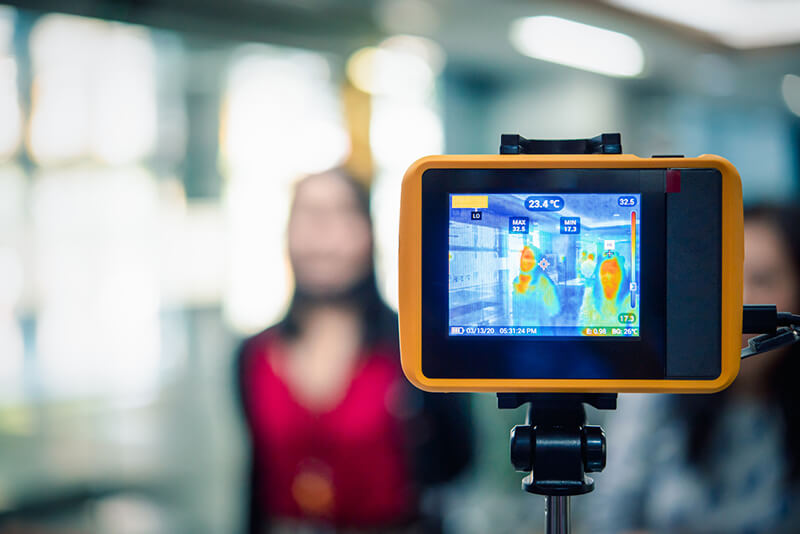As states and communities implement reopening plans during the COVID-19 pandemic, non-contact temp assessment devices may be used as part of an initial check at entry points to identify and triage people who may have elevated temperatures. Be aware that, even when the devices are used properly, temperature assessment may have limited impact on reducing the spread of COVID-19 infections. Some studies suggest that temperature measurements alone may miss more than half of infected people.
Thermal imaging systems and non-contact infrared thermometers, which are non-contact temperature assessment devices, may be used to measure a person’s temperature. An elevated temperature is one way to identify a person who may have a COVID-19 infection, although an infected person may be contagious without an elevated temperature or other easily detectable symptoms.
This page provides information on the use of non-contact temperature assessment devices during the COVID-19 pandemic. For general information on strategies for community mitigation to reduce or prevent local COVID-19 transmission, see the CDC’s Implementation of Mitigation Strategies for Communities with Local COVID-19 Transmission.
On this page:
- About non-contact temp assessment devices
- Benefits of non-contact temp assessment devices
- Limitations of non-contact temperature assessment devices
- Manufacturer labeling and instructions for use
Related pages:
- Thermal Imaging Systems (Infrared Thermographic Systems / Thermal Imaging Cameras)
- Non-contact Infrared Thermometers
About Non-contact Temperature Assessment Devices
Establishments such as businesses, transportation systems, and community organizations are developing plans to resume normal or phased operations during the COVID-19 pandemic. These plans may include an initial assessment to try to identify people who may be infectious to limit the spread of COVID-19 infections. Temperature measurement can be one part of the assessment to determine if a person has an elevated temperature potentially caused by a COVID-19 infection. One method to measure a person’s surface temperature is the use of “no-touch” or non-contact temperature assessment devices, such as thermal imaging systems (also known as thermal imaging cameras or infrared tele thermographic systems) or non-contact infrared thermometers. The use of other temperature assessment devices, such as oral thermometers, requires physical contact which may increase the risk of spreading infection.
The available scientific literature supports using thermal imaging systems and non-contact infrared thermometers to detect elevated temperatures. These devices have many benefits, but they must be used properly to get accurate readings. Since an elevated temperature does not conclusively indicate a COVID-19 infection, further evaluation and diagnostic testing are needed to determine if someone has a COVID-19 infection.
For the FDA’s recommendations on the benefits, limitations, and proper use of these devices, see:
- Thermal Imaging Systems (Infrared Thermographic Systems / Thermal Imaging Cameras)
- Non-contact Infrared Thermometers
Benefits of Non-contact Temperature Assessment Devices
- These non-contact devices can quickly measure and display a temp reading so a large number of people can be evaluated individually at points of entry.
- Non-contact infrared thermometers require minimal cleaning between uses.
- Using non-contact temp measurement devices may help reduce the risk of spreading COVID-19 infections.
Limitations of Non-contact Temperature Assessment Devices
Non-contact temp assessment devices are not effective if used as the only means of detecting a COVID-19 infection. Available scientific literature has identified that effectiveness can be limited by several factors, including:
- Infections without a fever;
- Use of fever-reducing drugs;
- Other infections or conditions that may cause elevated temperatures;
- Devices failing to identify elevated temperatures, or misreading normal temperatures as elevated;
- Failure to follow the manufacturer’s instructions for use, such as for set-up, operation, and training.
Manufacturer Labeling and Instructions for Use
The manufacturer’s labeling for each thermal imaging system and non-contact infrared thermometer has specific instructions for use and additional information that the user of the device should follow to increase accuracy. Temp measurements can also be affected by several factors including, but not limited to, the person’s clothing (including hats and scarves), the testing location and device preparation, the training of the person handling the device, and environmental factors such as room temperature and relative humidity.
![]()
If you would like liquidvideotechnologies.com to discuss developing your Home Security System, Networking, Access Control, Fire, IT consultant, or PCI Compliance, please do not hesitate to call us at 864-859-9848 or you can email us at deveren@liquidvideotechnologies.com.


Recent Comments